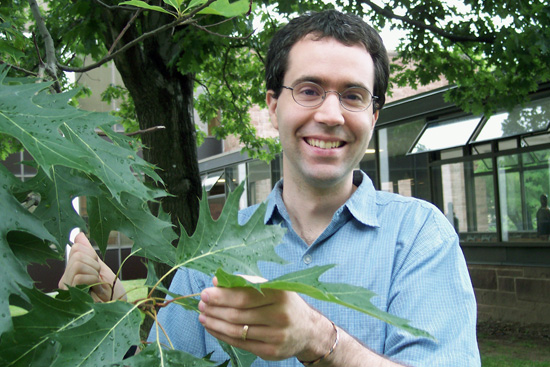Study Gives Teeth to Leaf Activity
 |
|
Dana Royer, assistant professor of earth and environmental sciences, researched why pointy-leafed plants are more common in colder climates. |
| Posted 04/01/06 |
| Smooth or pointy is there a reason?
If that question refers to a leaf, a study by a Wesleyan researcher may have an answer that includes some cold facts about sap flow and the weather. The study by Assistant Professor of Earth and Environmental Sciences Dana Royer and featured in a recent issue of the International Journal of Plant Sciences looks at the characteristics of plants with pointy leaves versus smooth-leafed plants and finds the difference is more than just cosmetic. The pointy or toothed leaves contain high concentrations of xylem, a type of tissue that facilitates the transportation of the plants sap, which is rich with nutrients and water. The water then evaporates from the leaves causing the plants to draw up even more sap. The result is a greater rate of sap flow earlier in the spring, says Royer. The process apparently helps to jumpstart the plants photosynthetic season. This may explain why so many trees and other plants in colder climates have pointy leaves. The colder the climates generally have shorter growing seasons so the greater rate of sap flow is very beneficial to these plants, says Royer. The trade-off is that there is a higher rate of water loss among these plants. So there still needs to be sufficient rain during the growing season. Royer and co-author Peter Wilf from Pennsylvania State University performed the study by analyzing the moisture transpiration and photosynthesis activity of more than 60 woody species in two decidedly different regions: Pennsylvania and North Carolina. They found that photosynthesis and transpiration activity increased by as much as 45 percent among toothed-leafed plants during the first 30 days of the growing season. The analogous rates of smoothed-leafed plants in the same regions were significantly less. The findings, while not definitive, certainly provide yet another example of natures ability to adapt to varying conditions. However, Royer adds that, in this case, there could be negative implications with climate change. Its very speculative, but most of these toothed leaf trees are hardwoods that, along with their environmental benefits, also carry economic value, Royer says. It would not take a large rise in average temperatures during the growing season to put point-leaf plants at a competitive disadvantage. |
| By David Pesci, director of Media Relations |

